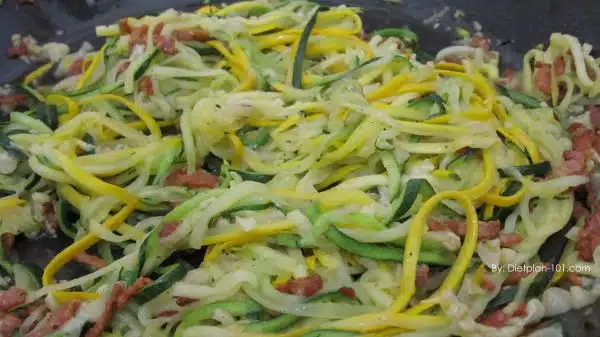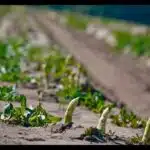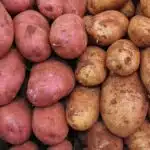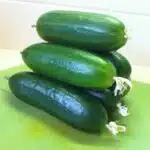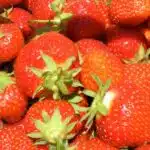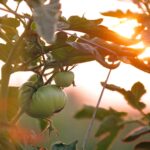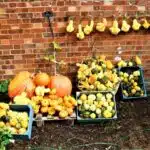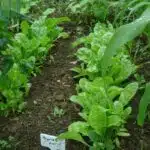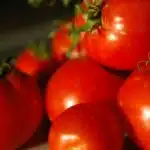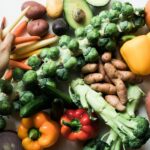As a zucchini harvesting expert, I have spent many years cultivating and harvesting this versatile vegetable. Zucchini is a popular summer crop that can be used in a variety of dishes, from salads to sautés, and even baked goods. However, knowing when and how to harvest your zucchini can make all the difference in the quality and quantity of your crop.
Harvesting zucchini at the right time is crucial for optimal flavor and texture. Picking too early or too late can result in tough or bitter fruit. Additionally, proper harvesting techniques can help extend the life of your zucchini plant and ensure a continued harvest throughout the season. In this article, I will share my expert tips on how to harvest zucchini for maximum yield and flavor. Whether you are a seasoned gardener or new to growing zucchini, these tips will help you get the most out of your crop and serve others with delicious homegrown produce.
Understanding Zucchini Growth Cycles
As the old adage goes, “you reap what you sow.” This couldn’t be truer when it comes to growing zucchini. Understanding zucchini growth patterns is crucial to ensure a bountiful harvest. Zucchini plants are typically grown during the summer months and can grow up to two feet tall. They require ample sunlight, water, and well-fertilized soil.
Zucchini growth follows a predictable cycle. The plant starts with a seed that germinates within five to ten days after planting. Once the seedling emerges from the soil, it will begin to produce leaves and stems. As the plant continues to grow, it will eventually produce male and female flowers. Insects such as bees and butterflies play a vital role in pollinating these flowers, which leads to fruit production.
The optimal harvest time for zucchinis is critical for their taste and texture. Harvesting too early or too late can result in an inferior product. The ideal time to pick zucchinis is when they are six to eight inches long and two inches in diameter. At this stage, they are tender and have not yet developed hard seeds or thick skin. It’s best to harvest them early in the morning or late in the evening when temperatures are cooler because they will wilt quickly if left out for too long during peak heat hours.
Choosing The Right Harvest Time
To ensure a flavorful and bountiful harvest, it is crucial to choose the right time to harvest your zucchinis. Harvesting too early or too late can significantly impact the quality of your crop. It is best to pick zucchinis when they are still young and tender, which typically occurs around 4-6 days after pollination.
Harvesting tools play an essential role in ensuring a smooth and efficient harvesting process. Using sharp pruning shears or scissors can help minimize damage to the plant while making clean cuts on the stem. It is also important to wear gloves while harvesting to protect your hands from potential scratches or irritation from the plants’ prickly stems.
Different zucchini varieties have varying optimal harvest times. Some varieties may be ready for harvest as early as 35 days after planting, while others may take up to 60 days. It is crucial to familiarize yourself with the specific variety you are growing and its expected maturity date. Keep in mind that regular harvesting encourages continuous production throughout the season, leading to a more abundant crop.
Transition: Now that we know how important it is to choose the right time for harvesting zucchinis and what tools are necessary for a successful harvest let us examine how examining their color and size can help determine their readiness for picking.
Examining The Zucchini’s Color And Size
1.When harvesting zucchini, it is important to inspect the color of the zucchini. Generally, zucchini should be a dark green or light green. 2.In addition to examining the zucchini’s color, its size should also be taken into consideration. Zucchini harvested at the right time should be about six to eight inches in length. 3.It is generally recommended to harvest zucchini when they are smaller in size, as this tends to yield a more flavorful vegetable. 4.When harvesting zucchini, it is important to inspect the color and size of the zucchini in order to ensure that the vegetable is of optimal quality.
Examining Zucchini Color
When it comes to harvesting zucchini, examining its color is a crucial step. The shade of green that the zucchini possesses can indicate its nutritional benefits. The darker the green, the more nutrient-rich the vegetable is. Zucchinis are known for being low in calories but high in fiber, potassium, and vitamin C. By examining the color of your zucchini, you can ensure that you are getting the most nutritional value from your harvest.
It’s also important to compare the color of your zucchinis with other varieties of squash. While they may look similar, not all squash have the same nutritional benefits. For example, yellow squash tends to be lower in nutrients than zucchinis due to their lighter color. Therefore, by paying attention to your zucchini’s color, you can ensure that you are harvesting a vegetable with optimal health benefits.
In conclusion, examining the color of your harvested zucchini can provide insight into its nutritional benefits compared to other varieties of squash. By harvesting zucchinis with a rich dark green color, you can ensure that you are getting a nutrient-rich vegetable that will add both flavor and health benefits to your meals. So next time you’re out in your garden picking vegetables or at the grocery store shopping for produce – remember to pay close attention to your zucchinis’ color!
Zucchini Size
As a zucchini harvesting expert, it is important to note that examining the color of your harvested zucchinis is not the only factor in determining their nutritional benefits. The size of your zucchini also plays a crucial role. Zucchinis come in a variety of sizes, from small and slender to large and plump. However, the optimal size for harvesting depends on the specific growing conditions.
Zucchinis grow best when they are harvested at a young age, typically between 6-8 inches in length. This size ensures that the vegetable has reached its peak flavor and texture while still retaining its high nutrient content. As zucchinis continue to grow, they can become tough and bland in taste. Therefore, it is essential to harvest them at the right size for optimal taste and health benefits.
When determining the appropriate size for harvesting your zucchini, it’s important to consider its growth conditions. If you are growing your zucchinis in ideal conditions with ample sunlight, water, and nutrients, they may reach their optimal size faster than if grown in less favorable conditions. In these cases, it’s important to monitor your zucchinis closely to ensure they are not overripe or too large for harvesting. By taking into account both the size and color of your zucchini, you can ensure that you are getting the most nutritional value from your harvest.
Assessing Zucchini Skin Texture
Zucchini skin texture is a crucial factor to consider when harvesting this versatile vegetable. The skin of a zucchini can provide insight into its ripeness and quality, affecting both its taste and texture. Evaluating zucchini skin texture is essential before cooking or consuming it.
Ripeness evaluation is the first step in assessing zucchini skin texture. Mature zucchinis have smooth, shiny skin with vibrant colors and no blemishes. The skin should feel slightly firm to the touch, indicating that it is not overripe. Overripe zucchinis have dull and soft skins with visible bruises, while underripe ones usually have rougher skins and may still be small in size.
Cooking considerations are also important when evaluating zucchini skin texture. The ideal texture for cooked zucchinis varies depending on the recipe. Some dishes require tender and juicy flesh, while others call for firmer textures that hold their shape after cooking. Understanding these differences will help you choose the right type of zucchini for your recipe, resulting in a more satisfying meal.
When evaluating zucchini skin texture, it’s essential to identify signs of overripe or underripe zucchinis before cooking them. These signs include dull or soft skins for overripe ones and rough or small sizes for underripe ones. By understanding these factors, you can ensure that your cooked dish has the perfect texture and flavor that will satisfy your guests’ palates without compromising quality or nutrition.
Identifying Signs Of Overripe Or Underripe Zucchini
The color of a zucchini is an indicator of ripeness, with an underripe zucchini having a lighter green hue and an overripe zucchini having a more yellow or orange tinge. The texture of a zucchini is an important factor, with an underripe zucchini having a firmer, more waxy feel than an overripe zucchini, which will have a softer, more tender texture. Weight is also a factor in determining a zucchini’s ripeness, with an overripe zucchini being heavier than an underripe one. Finally, the smell of a zucchini can be used to differentiate between overripe and underripe, with an overripe zucchini often having a more distinct, vegetal smell than an underripe one.
Color
As a zucchini harvesting expert, it is important to identify the signs of overripe or underripe zucchini. One way to do this is by examining the zucchini’s color. Zucchini color grading can help you determine whether a zucchini is ready for harvest or not. The ideal color for a ripe zucchini is dark green with no yellow spots or blemishes.
However, it is important to note that there are color variations in zucchini depending on the variety and growing conditions. Some varieties may have lighter green skin while others may have stripes or speckles. In addition, environmental factors such as temperature and sunlight exposure can affect the color of the zucchini.
To ensure that you harvest your zucchinis at their peak ripeness, regularly check the color of the fruits. Overripe zucchinis will have a yellow tint and may even have soft spots or mold growing on them. Underripe zucchinis will be light green in color and may still have small bumps on their skin. By closely monitoring the color variations in your zucchinis, you can guarantee a bountiful harvest of perfectly ripe vegetables for your kitchen table.
Texture
As zucchini harvesting experts, it is crucial to identify the signs of overripe or underripe zucchini to improve their flavor and maximize yield. Apart from color grading, texture is another factor that can help determine a zucchini’s ripeness. A ripe zucchini should have a firm and smooth texture with no soft spots or bruises.
To check for the right texture, gently press your finger on the skin of the zucchini. A ripe one will be slightly firm but still give a little when pressed. Overripe ones will feel mushy and have a spongy texture, while underripe ones will be hard and tough to the touch.
Harvesting zucchinis at their peak ripeness ensures that they are full of flavor and nutrients. By monitoring not only their color but also their texture, you can guarantee that your harvest will result in delicious dishes for you and your loved ones to enjoy. Remember to handle them carefully during harvesting and transportation to avoid any damage that could affect their texture.
Preparing Tools For Harvesting
Like any task, preparing for zucchini harvesting requires the appropriate tools. Before getting started, it is essential to gather the necessary equipment to make the process as efficient and effective as possible. In this section, we will discuss how to choose appropriate gloves and sharpen knives for harvesting zucchini.
Firstly, choosing appropriate gloves is crucial when it comes to zucchini harvesting. Gloves protect your hands from prickly leaves and stems that can cause skin irritation or cuts. They also keep your hands clean and help prevent any contamination of the produce. When selecting gloves, look for ones that are durable, flexible, and fit well. Nitrile gloves are a popular choice as they are both comfortable and provide excellent protection.
Secondly, sharpening knives is key for successful zucchini harvesting. A sharp knife ensures clean cuts that do not damage the plant’s stem or fruit itself. It also makes it easier to harvest quickly and efficiently without having to struggle with dull blades. To sharpen knives properly, use a honing stone or sharpening steel tool. Begin by holding the blade at a 20-degree angle against the stone and moving it in circular motions until it regains its sharpness.
In summary, selecting appropriate gloves and sharpening knives are essential steps in preparing for zucchini harvesting. These tools ensure safety during work while also making the process more efficient. By following these guidelines, you will be ready to move onto proper cutting techniques for zucchini in our next section without any hesitation or setbacks.
Proper Cutting Techniques For Zucchini
As a zucchini harvesting expert, I know that harvesting zucchinis can be a tricky task. To ensure a bountiful harvest and prevent plant damage, it is essential to use the right harvesting tools and cutting techniques.
Firstly, you should always use a sharp knife or pruning shears when harvesting zucchinis. Dull tools can damage the plant, making it more susceptible to disease and pests. When cutting the zucchini off the vine, make sure to cut at an angle rather than straight across. This angle will allow water to run off the stem instead of collecting on top of it.
Next, it’s important to hold the zucchini correctly when cutting it from the plant. Hold the fruit with one hand while using your other hand to make a clean cut through the stem. Avoid pulling or twisting the fruit since this could cause damage to both the fruit and plant.
To paint a picture for you, here are three sub-lists of proper cutting techniques for zucchinis:
- Use sharp harvesting tools such as knives or pruning shears
- Cut at an angle instead of straight across
- Hold the fruit with one hand while making a clean cut through the stem with your other hand
By following these proper cutting techniques for zucchinis, you’ll have a healthy harvest without damaging your plants. In the subsequent section, we’ll discuss how to avoid any further harm when handling these precious vines.
Avoiding Damage To The Zucchini Plant
Making proper cuts when harvesting zucchini can greatly affect the plant’s overall health. However, it is equally important to prevent damage to the plant during harvest. Damage can cause stress and even lead to disease, ultimately reducing the yield of future crops.
To prevent damage during harvest, it is recommended to handle the zucchini with care. Always use sharp pruning shears or a knife to make clean cuts at the stem. Avoid pulling or twisting the fruit off the plant, as this can easily break branches or damage leaves. Additionally, be mindful of where you step when walking through the garden; stepping on stems or branches can also cause damage.
Harvesting techniques may vary depending on personal preference and intended use for the zucchini. However, there are general guidelines that should be followed to ensure optimal quality and flavor. For best taste and texture, it is recommended to harvest zucchini when they are 4-8 inches in length and 1-2 inches in diameter. They should feel firm and have a shiny skin without any blemishes or soft spots. When harvesting larger zucchinis, remove them from the plant before they become too large and tough.
| Zucchini Size | Optimal Harvest Time |
|---|---|
| Small (4-6 inches) | Every other day |
| Medium (6-8 inches) | Every day |
| Large (over 8 inches) | Twice a week |
Properly storing harvested zucchini is just as important as harvesting techniques themselves. In order to maintain optimal freshness and flavor, store freshly harvested zucchinis in a cool place such as a refrigerator crisper drawer for up to one week. Be sure not to wash them until ready for use, as excess moisture can lead to spoilage. By following these tips for preventing damage during harvest and using proper harvesting techniques, you will enjoy delicious homegrown zucchinis all season long!
Storing Harvested Zucchini
- Zucchini should be harvested when the fruit is firm and brightly colored.
- After harvesting, it is important to rinse and clean the fruit to remove any dirt or debris.
- After cleaning, the zucchini should be dried thoroughly before storage to prevent mold growth.
- Proper storage of zucchini also requires that the temperature is kept cool.
- For optimal shelf life, zucchini should be kept in a refrigerator between 32-40°F.
- Stored in this way, zucchini can keep for up to two weeks.
Cleaning
In order to ensure that your harvested zucchini stays fresh and healthy, cleaning the vegetables is a crucial step. Best practices for cleaning zucchini involve using a gentle scrub brush or sponge along with cool water to remove any dirt or debris. Avoid using soap or chemicals during the cleaning process, as this can damage the skin of the vegetable and compromise its quality.
To effectively clean your zucchinis, you will need a few tools. A gentle scrub brush or sponge is recommended for removing dirt and debris. It’s important to use cool water when rinsing off the vegetables, as hot water can cause them to become mushy and lose their texture. Additionally, you may want to prepare a solution of one part vinegar to three parts water in order to soak the zucchinis before rinsing them off; this can help remove any lingering bacteria or pesticides.
When it comes to storing your freshly harvested zucchinis, taking the time to properly clean them is an important step in ensuring their longevity. By following best practices for cleaning and gathering together the right tools like gentle scrub brushes and sponges, you can help ensure that your zucchinis stay fresh and healthy longer. With these tips in mind, you’ll be well on your way to enjoying delicious meals made with your own homegrown produce!
Drying
As a zucchini harvesting expert, I believe that proper storage is crucial in ensuring the longevity and freshness of your harvested produce. Aside from cleaning, another important step in storing zucchinis is drying. Drying not only removes excess moisture but also helps prevent mold and bacterial growth, making it easier to store your harvested zucchinis for an extended period.
One of the most effective zucchini drying techniques is air-drying. Simply place your freshly cleaned zucchinis on a clean towel or rack and leave them to dry naturally for several hours or overnight. Alternatively, you can use a dehydrator to speed up the process. This method involves slicing the zucchinis into thin slices and placing them in a dehydrator set at 125°F-135°F until they are completely dry.
The benefits of dried zucchini are plenty. For one, they take up less space compared to fresh ones, making it easier for you to store more produce in your pantry or kitchen cabinet. Additionally, dried zucchinis can be used in a variety of recipes such as stews, soups, pasta dishes, and even as a healthy snack alternative. With these simple yet effective drying techniques, you can enjoy the benefits of dried zucchini all year round!
Cooling
Proper storage techniques are essential in preserving the quality of your harvested zucchinis. In addition to drying, cooling is another crucial step in ensuring that your zucchinis remain fresh for longer periods. Cooling involves reducing the temperature of your freshly harvested zucchinis to slow down the ripening process, thereby extending their shelf life.
One effective way to cool your zucchinis is by storing them in a refrigerator or a cool, dry place like a cellar or basement. Before storing, ensure that you have cleaned and dried them thoroughly to prevent moisture buildup. Avoid exposing them to direct sunlight or heat sources as this can speed up the ripening process and cause spoilage.
In conclusion, proper preservation techniques such as drying and cooling are vital in maintaining the quality and freshness of harvested zucchinis. By following these simple steps, you can enjoy your produce all year round while minimizing food waste. So go ahead and try out these techniques today!
Preserving Zucchini For Later Use
Once you have harvested zucchini, it is important to preserve them for later use. Freezing and dehydrating are two effective methods to keep zucchinis for a longer period of time.
Freezing is the easiest way to preserve zucchinis. To freeze, wash and slice the zucchinis into 1/4 inch pieces and blanch them in boiling water for three minutes. After blanching, cool them down quickly in an ice bath before draining excess water. Place them in freezer-safe containers or bags, removing as much air as possible before sealing. Frozen zucchinis can last up to 12 months.
Dehydrating techniques can also be used to preserve zucchinis. Thinly slice the zucchinis and place them on dehydrator trays, leaving space between each piece for airflow. Set the temperature at 125°F (52°C) and leave them until they are dry and crispy, which usually takes around eight hours. Once dried, store them in an airtight container at room temperature for up to six months.
Preserving zucchinis allows you to enjoy this nutritious vegetable throughout the year. Additionally, it saves your time from grocery shopping and food preparation during busy days when you crave healthy meals but have limited time on hand. In the next section, we will explore how to incorporate harvested zucchini into exciting dishes that will tantalize your tastes buds.
Using Harvested Zucchini In Cooking
- Zucchini is an extremely versatile vegetable which can be used in a variety of dishes, making it a great addition to any home cook’s kitchen.
- When harvesting zucchini, it is important to pick them when they are still on the small side as they will be more tender.
- To ensure the best quality of zucchini for cooking, the ideal time to harvest is when the fruit is between 6 to 8 inches in length.
- Recipes using zucchini can range from simple sautés to more complex dishes such as zucchini bread or stuffed zucchini boats.
- Zucchini can be stored in an airtight container in the refrigerator for up to five days, or they can be frozen for up to six months.
- Properly harvesting and storing zucchini can help ensure that home cooks get the most out of the vegetable when cooking with it.
Cooking With Zucchini
Zucchini is one of the most versatile vegetables that can be used in various recipes. It is a great source of nutrients and antioxidants that promote good health. Zucchini recipes are easy to make and can be prepared in numerous ways, making it a favorite among chefs and home cooks alike.
One of the health benefits of zucchini is its low calorie content and high fiber content, making it an excellent vegetable for weight loss. It also contains vitamins A, C, and K, as well as potassium, which helps regulate blood pressure. Additionally, zucchini is rich in antioxidants that protect against free radicals that cause cell damage.
When cooking with zucchini, it is essential to choose fresh and firm ones with smooth skin. To prepare them for cooking, wash them thoroughly under running water before slicing or chopping them into desired sizes. Zucchini can be grilled, roasted, sautéed or even baked into delicious dishes like zucchini lasagna or zucchini fritters. These recipes not only taste great but also provide a healthy alternative to traditional dishes.
In conclusion, zucchini is a must-have vegetable in any kitchen due to its versatility and health benefits. Incorporating it into your diet through zucchini recipes is an excellent way to maintain a healthy lifestyle while enjoying delicious meals. So why not head out to your garden to harvest some fresh zucchinis today?
Zucchini Recipes
As a zucchini harvesting expert, I cannot stress enough the importance of using harvested zucchinis in cooking. Zucchinis are a versatile vegetable that can be used in various recipes, making it an all-time favorite among home cooks and professional chefs alike. With the abundance of zucchinis during harvest season, it is only fitting to explore various zucchini recipe ideas to maximize its use.
Cooking with harvested zucchini is easy and enjoyable. It can be grilled, roasted, sautéed or baked into delicious dishes that cater to different taste preferences. One popular zucchini dish is the zucchini lasagna, where sliced zucchinis are used in place of traditional pasta sheets. This dish provides a healthy alternative while still satisfying one’s craving for lasagna. Another delicious recipe is the zucchini fritters, which are crispy on the outside and soft on the inside. These fritters make an excellent appetizer or snack and are perfect for entertaining guests.
Incorporating harvested zucchinis into your cooking not only provides an opportunity to experiment with different recipes but also promotes a healthier lifestyle. Zucchinis are low in calories but high in fiber content, making them an ideal vegetable for weight loss. They also contain essential vitamins and minerals such as vitamins A, C, K and potassium which promote good health. So why not take advantage of your garden harvest by exploring new ways to cook with harvested zucchinis?
Storing Zucchini
As a zucchini harvesting expert, it is important to not only know how to use harvested zucchinis in cooking but also how to properly store them. Storing zucchinis correctly can extend their shelf life and preserve their freshness, making them available for future recipes. When it comes to storing zucchinis, the key is to keep them in a cool and dry place with good air circulation.
One option for storing zucchinis is to place them in a perforated plastic bag or container in the refrigerator. The optimal temperature for storing zucchinis is between 32°F and 40°F. This method can keep zucchinis fresh for up to two weeks. Another way of storing zucchinis is by freezing them. Simply slice or shred the zucchini and place them in an airtight container or freezer bag before freezing. When stored properly, frozen zucchinis can last up to eight months.
It is important to note that while storing zucchinis, they should not be washed until ready to use as excess moisture can cause them to spoil faster. Additionally, avoid storing zucchinis near ethylene-producing fruits such as apples and bananas as this can cause them to ripen too quickly and spoil faster. By following these storage tips, you can ensure that your harvested zucchinis stay fresh for longer periods, giving you more opportunities to incorporate this versatile vegetable into your cooking repertoire.
Making Zucchini Bread And Other Baked Goods
As an expert in zucchini harvesting, I can assure you that there’s nothing quite like the satisfaction of picking a fresh batch of zucchinis from your own garden. With their tender texture and mild flavor, these versatile veggies are perfect for a wide range of culinary creations – from savory soups and stews to sweet baked goods like zucchini bread.
Speaking of which, there are countless variations on this classic recipe that are sure to please any palate. Whether you prefer yours plain or loaded up with nuts, chocolate chips, or even shredded carrots and apples, there’s no shortage of creative zucchini bread recipes out there to try. And if you’re feeling particularly adventurous, why not experiment with using zucchini in other baked goods as well?
In addition to traditional breads and muffins, you can also use grated zucchini to add moisture and nutrition to cakes, cookies, and even pancakes. And if you’re not much of a baker yourself, don’t worry – there are plenty of other ways to use up your bountiful harvest. From stir-fries and salads to stuffed squash boats and cheesy casseroles, the possibilities for creative zucchini recipes are truly endless. So go ahead and get cooking – your taste buds (and your guests) will thank you!
As any good gardener knows, one of the greatest joys of growing your own produce is being able to share it with others. So why not spread the love by passing some of your extra zucchinis along to friends and neighbors? Not only will you be doing a good deed by providing them with delicious fresh veggies, but you’ll also be helping to reduce food waste and build community connections in the process. And who knows – maybe they’ll be inspired to try out some new zucchini recipes themselves!
Sharing Your Zucchini Harvest With Others
As the aroma of freshly-baked zucchini bread fills the air, it’s a sign that the harvest season is upon us. Harvesting zucchinis can be a rewarding experience, but it requires some knowledge and technique to ensure a bountiful yield.
Sharing tips on how to harvest zucchinis can help others improve their gardening skills. The first step is to check the size of the fruits by examining their length and width. A mature zucchini should be around six to eight inches in length and approximately two inches in diameter. If they’re too small or too big, they won’t provide the same quality of taste or texture.
Creative ideas for sharing your zucchini harvest with others include donating them to local food banks or giving them away as gifts. Zucchinis are versatile vegetables that can be used in various dishes such as soups, salads, fritters, and even desserts. Sharing your bounty with others not only helps people who may not have access to fresh produce but also fosters a sense of community.
For those who encounter troubleshooting common zucchini harvesting issues such as pests or diseases, there are solutions available. By understanding these issues and taking preventative measures like using organic pesticides or rotating crops annually, gardeners can avoid these problems altogether. With proper care and attention, you’ll soon have an abundant supply of delicious zucchinis to share with those around you.
Troubleshooting Common Zucchini Harvesting Issues
Zucchini harvesting is a crucial aspect of maintaining a healthy garden, but it can sometimes be challenging due to common issues that arise during the process. One of the most prevalent problems is dealing with pests that can damage or destroy zucchinis before they are ready for harvest. To prevent pest infestations, it is essential to keep your garden clean and free of debris and dead plant material. Additionally, you can use natural pest control methods such as companion planting or using insecticidal soap.
Another issue that many gardeners face during zucchini harvesting is improper pruning techniques. Proper pruning helps to promote healthy growth and ensures that the fruit develops correctly. It is best to prune zucchini plants regularly by removing any dead or diseased leaves or stems. This will allow more sunlight to reach the fruit and reduce the risk of disease.
When troubleshooting common zucchini harvesting issues, it is crucial to take preventative measures such as dealing with pests and proper pruning techniques. By doing so, you’ll have healthier plants with higher yields and less waste. However, there are also other tips for a successful zucchini harvest season that every gardener should know. With these tips in mind, you’ll be able to enjoy fresh and tasty zucchinis all summer long!
Tips For A Successful Zucchini Harvest Season
Transitioning from the previous topic of troubleshooting common zucchini harvesting issues, let us now focus on tips that can help ensure a successful zucchini harvest season. As an expert in zucchini harvesting, I have found that maximizing yield and extending the season are two key factors to consider.
To extend your zucchini season, start by planting early and late varieties. Early varieties mature faster than others while late varieties provide a longer harvest period. This way, you can have a continuous supply of fresh zucchinis throughout the growing season. Another way to extend the season is to plant in succession. Plant new seeds every two weeks to ensure a continuous harvest.
To maximize your zucchini yield, it is important to maintain healthy plants and proper care. Keep the soil moist but not waterlogged, as overwatering can lead to root rot and other diseases. Ensure adequate sunlight exposure by planting in an area with at least 6-8 hours of direct sun daily. Regularly fertilize your plants with balanced nutrients such as nitrogen, phosphorus, and potassium.
Table: Comparing Early and Late Zucchini Varieties
| Variety | Maturity Period | Harvest Period |
|---|---|---|
| Early | 45-55 days | Short |
| Late | 60-70 days | Long |
In conclusion, by following these tips for extending your zucchini season and maximizing yield, you can enjoy a bountiful harvest throughout the growing period. Remember to also keep an eye out for any potential issues such as pests or diseases that may impact your crop’s growth and take necessary measures promptly. With proper care and attention, you can successfully grow healthy zucchinis that will make delicious additions to your meals.
Conclusion
Understanding the growth cycles of zucchini is critical to ensuring a successful harvest season. It is essential to select the right time to pick your zucchini, examining its color, size, and skin texture carefully. Overripe or underripe zucchinis can be identified by their dull color and soft texture, respectively.
While zucchini bread and other baked goods are delicious, sharing your bountiful harvest with others is equally fulfilling. However, one must be mindful of common harvesting issues, such as pest infestations and improper storage techniques.
As a seasoned zucchini harvesting expert, I implore you to take these tips into consideration for a fruitful harvest season. Remember that timing is everything in the world of zucchinis – too early or too late can lead to disaster. But with careful attention and patience, you can enjoy a bountiful crop of this versatile vegetable. So go ahead and get your hands dirty – there’s nothing like the sweet satisfaction of reaping what you sow (or plant).
Image Credits
- “Stir-Fried Zucchini Noodle with Bacon and Parmesan” by oonhs (featured)

